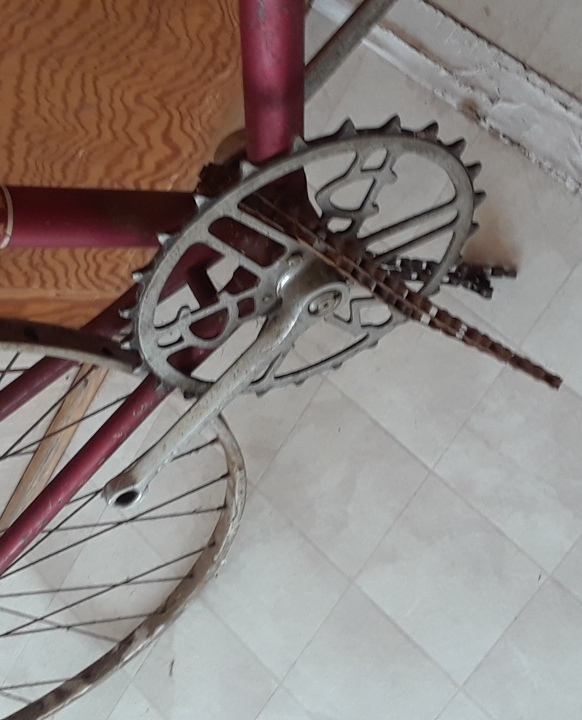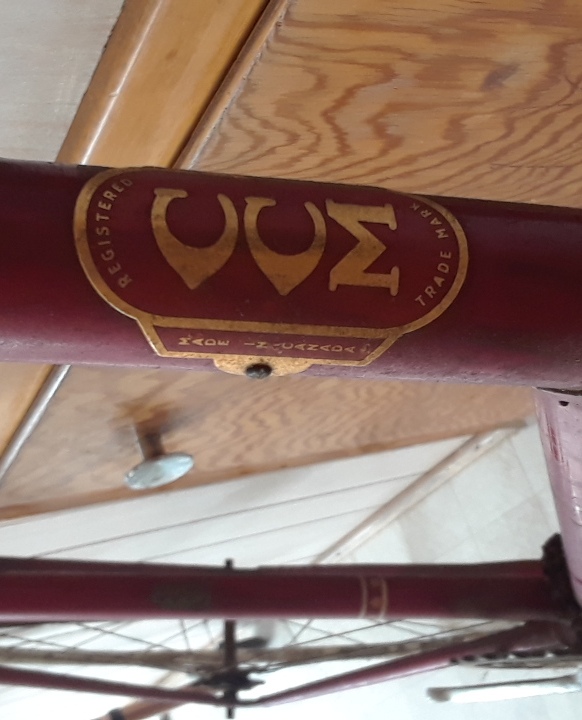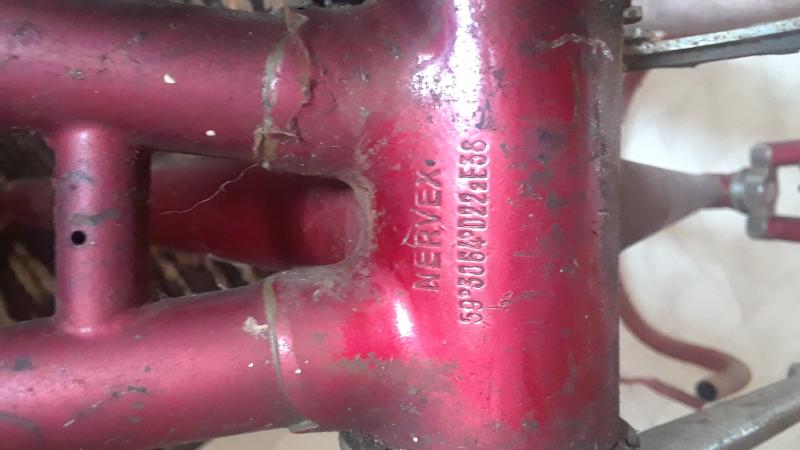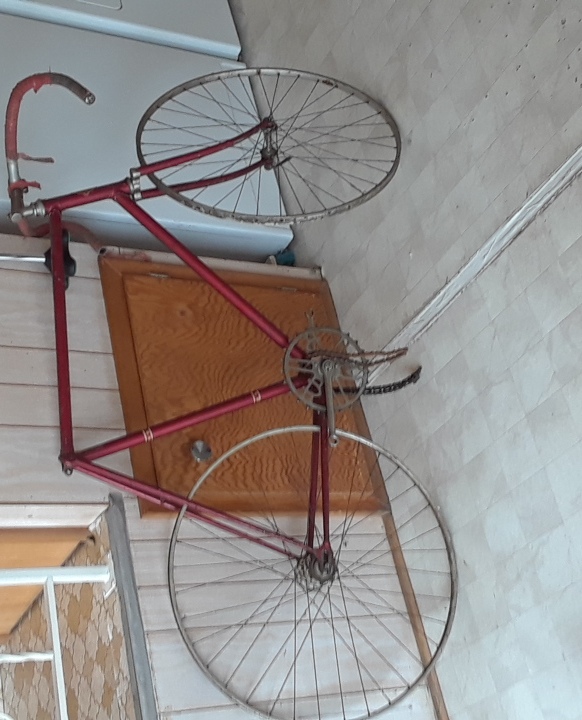Vintage CCM track bike to Id
Look for information and history to identify this CCM track bike, It belonged to Harvey Philips which he used during the 1950s for 6 day bike races in Ontario.
I understand that this track bike came with a road bike as a paired set, If that is true i'd be nice to find it
sincerely 












Very nice bike. Does it take glue on tires
Dave
Congratulations. You have found one of the extremely rare CCM Prolite Flyers made between 1954 and around 1959. CCM was struggling to produce a lightweight racing bike, in both road and track models, that would be the equal of the English and European bikes that were available. I think that CCM sourced the parts for these from suppliers in England. They featured French Nervex lugs, Reynolds 531 double butted tubing, and some other English and European frame fittings. The frames were put together by Hallie Lemmon in CCM's newly established model shop. Some Canadian riders in major competitions used these bikes. Pat Murphy had 4 of them and CCM gave at least one of them to Torchy Peden. Lorne Atkinson of Ace Cycle in Vancouver told me that he did not see any of these supplied by CCM after 1959.
If you ever decide to part with it I am very interested.
John Williamson
i have a couple of front chain rings for this model that are new or very close to it william rudolph
Hello Bill, I would be interested in one of your CCM chainrings. Maybe I could call you later today,Thanks Jamie
Very cool! I've never seen one. I'm surprised to see these bikes still using a 1" pitch chain that late. Does anyone know the advantage for that? I can't see it being lighter.
Track bikes did use inch pitch chains, but they were block chains and not roller chains. Block chains were more solid than roller chains and they were more efficient in the initial start and when riders would "jump". They are quite rare now.
chain rings prolite purchased by ken martin
Yaa
Yaa haa
While the subject bicycle is equipped with a 1" pitch block chain, I believe this is owner preference. By the time that CCM introduced the Prolite Flyer track model in 1954, they appear to have switched to 1" pitch roller chains. This is what was on another Prolite Flyer Track model that I saw for sale locally and is supported by the 1954 catalogue. While the specifications for the Prolite Flyers do not contain any chain information, the catalogue does not list a block chain in the parts section. The only 1" pitch chain offered is a roller model.
While there were Prolite Flyer Road models offered during the this era, I haven't seen any evidence to indicate that they were sold as a matched pair.
As noted by John, 1" pitch block chains were preferred by many track riders, due to their power transmisson characteristics. Being simpler and more rigid than a roller chain, they responded slightly more quickly to power input. They were also less likely to break due to the solid block and were more stiff laterally, decreasing the probability of chain deraillment. In addition to the solid block, retention of the old 3/16" width aided in reliability and rigidity. On the down side, they were slightly less efficient, noisier and not as smooth.
During the post World War II era, with improvements in metallurgy and increased emphasis on lighter weight, track riders started to to migrate towards 1" x 3/16" roller chains and later, 1" x 1/8" and 1/2" x 1/8" roller chains.
I am not sure if this was the case with the inch pitch chains, but some parts used on the Prolite Flyers were not shown in the catalogues. This is probably true for the headsets, the aluminum seat posts, some handlebars and stems, front derailleurs and double chainsets, and some types of Ambrosio rims. I have some good pictures of Pat Murphy's CCM Flyer Prolite Flyer track bike. I will check to see if he was using a block chain.
John, I appreciate your viewpoint. I've made the same observation regarding the cataloguing of components for some of CCM's specialty models. However, chains are a consumable item and a rider, especially a pro, would go through multiple chains in a year. Consequently, it seems improbable that CCM would not catalogue the OEM chain as a standard item. Given that the only1" pitch chain catalogued in 1954 was a roller chain and the Prolite Flyer Track model was the only model using a 1" pitch transmission at that time, it appears to me that a 1" pitch roller chain would be OEM.
Even if there are examples of extant Prolite Flyer Track models with block chains, I would not put much credibility in it. The chain is unlikely to be OEM, due to their high rate of replacement.
By the way, in my previous post, I neglected mention another disadvantage of 1" pitch, relative to 1/2" pitch - decreased gearing selection.
Tom, I checked my pictures of the Pat Murphy track bike and it does indeed have a roller chain on it. I know that he got rid of his 4 Prolite Flyers by the end of the 1950's and I do not think it has been changed in any way since then. You could ask how these 1950's Prolite track Flyers came to have inch pitch sprockets and chainrings in the first place (none of which was shown in the catalogues at that time). CCM was in the habit of using up old stock. I know that they still had a box of the 1940 Flyer large flange ("telephone dial") hubs in the mid 1950's in their parts department. These hubs were made by Schwinn for CCM and are super rare. In short, it will have to remain a mystery as to whether or not CCM actually put block chains on the '50's Flyers. All of the people I knew that could answer this question have passed away. I will post a few pictures soon.
CCM "Racing Catalogue"
Pat Murphy Flyer front sprocket.
Pat Murphy Flyer rear sprocket.
Hello John,
Are the pedals on the Pat Murphy bike Phillips Credalux?
This summer I will be assembling my 1951 and 1955 Flyers, I need to make a choice on what pedals to use.
I have one set of Phillips Vitesse pedals (not in great shape) and a couple of sets of very good Credalux pedals.
More Photos of the frames at this link:
https://www.flickr.com/photos/moonm/albums/72157689446164712
Yaa haa haa
In reply to Tom's messages about the block chain, I think that we should consider the track events where this type of chain might be useful. The only one I can think of is the Sprint, where two riders start out together, go around the track a couple of times, jockeying for position, with the action heating up over the final 200m. and the winner being the first to cross the finish line. The total distance being 1000 m. This makes the block chain of very limited use, even on the track. Offhand, I do not recall any top notch Canadian track sprinters from the 1950's, although I am sure that there were some sprinters. Lorne "Ace" Atkinson told me that CCM had the Prolite Flyer available for the British Empire Games in Vancouver in 1954. CCM had an interest in providing their new Prolite Flyer to prominent Canadian riders in competition. Their were 2 types of Prolite Flyers available. The competiotion bikes had the 1st type of Nervex Professional lugs and had extra decals on the seat tube. The other type of Prolite Flyer had Nervex "Legere" lugs and was more for the public. The "Legere" lugs were still very attractive, but the Professional lugs were the best that Nervex offered.
To summarize, the actual need for block chains by Canadian riders in competition in the 1950's would have been minimal. The use of block chains on the track was an established practice that may not have had any real scientific basis. They are not being used now. Despite this, CCM was offering inch pitch sprockets and chainrings for many years. I believe that if CCM had felt that there was a Canadian sprinter in competition in the 1950's that wanted block chains, CCM would have provided them. Otherwise, the very low number of actual Prolite Flyer track bikes that were made could make do with roller chains.
Greg and Karl, there is a Rocky and Bullwinkle Fandom. Your comments might be more appropriate there. Although a lot of people might not care much about the history of these particular bikes, this has always strived to be a serious and respectful group.
John Greg and Karl are not to disrespect the seriousness of the forum or the discussions by any one and or You or Tony or Tmar Just having a little fun
thanks Enjoy the day
Gt
For anyone interested there is a good account of the inch pitch chain at this link:
https://www.classiclightweights.co.uk/lightweight_extras/the-inch-pitch-...
One of the track bikes mentioned in this article now resides in my collection (JRJ)
https://www.flickr.com/photos/moonm/collections/72157628707166153/
I very much enjoy the knowledge from this forum, Greg and I are serious bicycle collectors and value everyone's input. We like to have a little fun, some of you who know us can atest to this. That prolite flyer is a sweet bike, if I came across one in the wild I'd probably freak out, cool stuff.
great bike, super find
what are your plans for it?
please post pictures when you are done building it
forgot to ask
those are some tiny profiled rims
any markings on your rims and hubs?
to the connoisseurs ..... what rims and hubs were originally supplied by CCM for those bikes?
John, what year is your catalogue page from? cool info, thanks